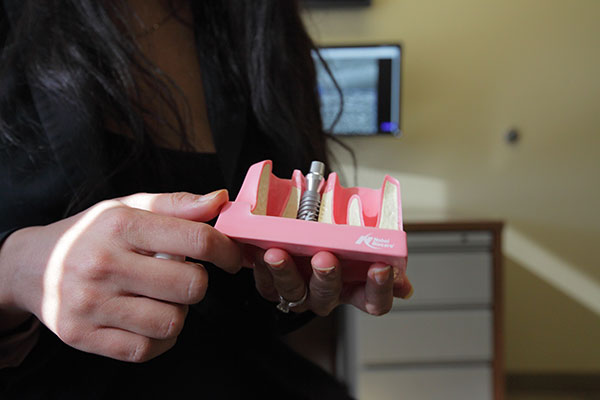DENTAL IMPLANTS
We can not only replace your teeth, but we can restore your teeth with a permanent solution. Traditional replacement of teeth includes the use of a false tooth that is supported by neighboring teeth, such as a bridge or denture. Restoring your tooth provides our patients with an individual tooth, placed on a surgically implanted root, known as a dental implant. By restoring the root, our team at Woodland Hills Oral & Maxillofacial Surgery can provide our patients a tooth that will not damage or decrease the strength of neighboring teeth. This means a more permanent, stronger and stable solution, even in the event of significant facial trauma.
WHAT ARE DENTAL IMPLANTS?
Your own natural tooth consists of three connecting pieces, the jaw, the root and a crown. When a tooth is lost, so is that middle connective piece, the root which anchored the tooth to the jaw. If we place a false tooth, there is nothing to anchor it to the jaw. So, dentists have traditionally retained the false tooth by anchoring it to neighboring teeth. This system does keep a false tooth in place, but does require the permanent alteration and can cause heavier wear on otherwise healthy teeth. A dental implant is restoring that root, surgically placing the middle piece that is missing. The three pieces can then be brought together again, stabilizing the tooth without relying on neighboring teeth. Implant-supported replacement teeth use the same basic parts as your natural teeth. They both consist of the jaw, the root, and a crown.
The newly implant root is a titanium metal post. This is the same material that is used by surgeons for repair all over the human skeleton, including artificial joints. We use titanium because it is lightweight, yet very strong, and most importantly, biocompatible. This means that your body will not reject it. As the bone heals around the implant, it actually bonds to the implant, making the two into one. This healing process is known as osseointegration, or the taking in into the bone. Once the implant and bone have fused together, the patient is left with a strong, permanent solution.

SURGICAL ADVANCES IN DENTAL IMPLANTS
Using the most advanced procedures and technology in dental implant surgery, our team, including Dr. Robert G. Hale and Dr. James P. Jensvold can place single stage implants. The unique feature of these implants is that they do not require a second procedure to uncover them, but will still require adequate time for healing before artificial teeth are placed, this is six weeks. Working with our team, we may even be able to place your implant at the same time of extraction of the natural tooth; this will depend on your specific situation.
The surgical procedure for placing implants is a minimally invasive procedure. We take the necessary steps in planning, using 3D radiographs, before treatment is done. On the day of the procedure, our surgical team at Woodland Hills Oral & Maxillofacial Surgery will make sure the patient is comfortable, we will discuss varying options of local and conscious anesthesia. Once the patient is comfortable, either Dr. Robert G. Hale or Dr. James P. Jensvold, will open the tissue to expose the bone. Using a specialized drill, the space will be made to receive the implant, the implant is placed and the area is then sutured closed. The entire process will take about one hour. The patient will then be sent home with care instructions, most patients find that they can resume normal activities within a day or two.
Dental implant placement is a team effort between an oral and maxillofacial surgeon and a restorative dentist. Dr. Robert G. Hale or Dr. James P. Jensvold performs the actual implant surgery, initial tooth extractions, and bone grafting if necessary. We want to make sure our patients are given the proper extractions surgical instructions. Once the implant is placed, we will refer you back to your restorative dentist for prosthetic fitting and placement. Read more about the cost of dental implants. For more information, contact our Woodland Hills office. Our front office staff is here to assist you. (818) 999-0900
